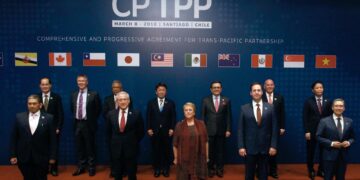Consider the scale, the scope, and the stakes of the engagement of American businesses with China today: it’s a regional base, a place to tap engineering and manufacturing resources, an important market, and a breeding ground for global competitors. China in 2013 also presents increasing operational challenges for foreign firms and their executives, including increasing scrutiny by Chinese regulators, a more stressful physical environment, and the commercial pressures of rising costs and maturing markets.
In this climate of rising external pressures, it’s worth asking how companies can strengthen internally. For many companies, the stakes are high enough that teams may find themselves being forced to abandon unproductive old patterns. To thrive in today’s China business environment, companies should be asking: “Do our people based in the United States and in China work together to define and address issues? Does everyone involved have the knowledge, skills, and motivation to work as a team?”
If your answer is yes, your group is an elite performer in the world of US-China business. A high functioning cross-cultural team is both a powerful foundation for building personal and organizational success—and a rare phenomenon. I’ve seen very few of them in my nearly three decades of China experience. More typically, the team dynamic creates internal conflict, lost opportunity, and high stress. High-functioning teams exist because the top leadership has specifically made team dynamics a top priority: they won’t form organically and they do not run themselves.
A team that pulls together and agrees on a few critical things—the nature of the problem, the nature of a response, and the composition of resources to implement a response—creates competitive advantage for the business as well as a more rewarding workplace for the individuals involved. But patterns that appear often in the structure of US-China business work against the formation of high functioning teams. Three dysfunctional patterns tend to emerge: tension between in-country teams and headquarters, tribalism, and resistance to engaging outside help.
The classic divide
There are many valid reasons why China-based management, on one hand, and China-accountable management living outside China, on the other, see things differently. Business ecosystems in China and the United States, respectively, are grounded in massive systemic differences, not to mention a very significant culture gap. As a result, people in each environment develop different knowledge bases, skill sets, and even overall outlooks and philosophies. Compare the motivations and lifestyle preferences of HQ-based corporate stars and committed, long term expats. Consider what each one does not know about the daily reality of the other. Depending on who holds the agenda, entire departments tend to face to one side or the other. For example, legal typically looks to HQ, while operations are led by China. Quality and marketing are often tasked by HQ, while human resources and sales take their cues from domestic leadership.
Organizations are strengthened by acknowledging and dealing directly with the disconnect. Left to their own devices, there likely will be continuing tension between US- and China-based teams. “One pain point for the US-based headquarters I see often is finding the balance between a China team that needs to be given some autonomy and initiative, but sometimes ends up creating its own end goals, agendas, and processes that stray too far from the corporation’s,” says Michael Zakkour, principal at consulting firm Tompkins International. “This can result in companies losing control of their brand, their in-country strategies, and their tactics and reputation.”
Tribalism
Wherever ecosystems and cultures diverge, fault lines often form to divide would-be allies. At universities, administrators face off against faculty. In law enforcement, precinct cops, homicide detectives, and the Feds battle for turf.
But in US-China team dynamics, the gap is bigger than divergent agendas and leads to dysfunction and polarization. Both sides invoke language, time zones, political systems, and culture in a refrain about how the other side will just never get it. Both sides buy into the idea that there cannot be open, realistic discussion to define problems and solutions. When it comes to China’s commercial logic, economic infrastructure, workplace dynamics, or group and individual motivations, the China side believes that it can’t possibly explain and HQ employees can’t possibly understand. Distance becomes polarization.
The narrative of misunderstanding between the “China Tribe” and “HQ Tribe” often stars the “China Guy.” Remember the China Guy? Almost every American company, even the largest of multinationals, once launched into China on the advice of a go-to consultant. Invaluable in the early stages, the China Guy was there to brief the lawyers and accountants, plan itineraries, identify partners, negotiate the first agreements, name the management team candidates, and dispense all manner of China intelligence and advice.
Though the era when one superhuman “China Guy” could handle everything is long gone, bad memories linger and wrong lessons were learned:
- The HQ Tribe believes that business is business—and it’s universal logic. Anyone who describes the behavior of Chinese staff, markets, regulators, or competitors in a way that HQ sees as illogical must be hiding something or is confused.
- The China Tribe believes that China has its own logic, and that if HQ refuses to accept reality, there’s no point trying to explain. If HQ needs to be involved, it’s best to keep the conversation short.
As communication dries up, the executives who fly in and out of China gain enough confidence in their China knowledge to sideline the China Guy. When this happens, strategy gets taken over by functional leaders in finance, production, and sales. The tribal lines are drawn.
Crisis strikes
US-China teams often resist engaging outside help. The need to have it under control—every operating, commercial, or regulatory issue, however sudden, untimely, opaque, unfamiliar, or intractably complex it may be—allows external chaos to become internal crisis.
In the words of China Law Blog’s Dan Harris, “The legal department doesn’t flinch at paying $10,000 for a contract. But if I suggest, based on what I have seen about their business, that management consider hiring a specialist to work through the operational aspects, it doesn’t happen.”
Harris says increased regulatory attention to foreign firms has created an “explosion” of Customs-related cases for his firm, Harris & Moure. “I know a crack Customs specialist – someone with the detailed knowledge and skills to resolve serious issues with Chinese Customs at key ports. How many people do you know that can do that? So I recommend him all the time. Yet when I talk to him, he says he could use a lot more work. Another example: I know top-drawer quality guys who can do factory check-ins, and keep production on track for fees starting at $500 a month. You’d think that a client who pays five figures for a contract and loses sleeps over quality issues would want those contacts.”
Why don’t foreign firms follow Harris’ advice? They don’t want to insult the China Tribe, who may think that HQ doesn’t understand life in the trenches, can’t calibrate China talent, and that the specialists’ ideas will cause more problems than they will solve. I know how they think—I was a card carrying member of China Tribe for almost 20 years.
A way forward
The root of all these issues is an inability to see the other side as fully competent, but you can move forward by developing the shared assets of successful US-China teams.
Shared, basic China business knowledge
One approach is to establish a framework and vocabulary that both sides refer to in defining the issues. There is no shortage of China business books, blogs, trainers and consultants, who bring their own experiences to this task. Most consulting firms have a methodology for understanding the market, vetting partners, calibrating hires, and many firms also focus on specific sectors.
There are also independent practitioners. Andrew Hupert, a specialist in China negotiation training, helps the HQ Tribe understand the how their misunderstanding of Chinese-style negotiation practices may be costing them dearly. Hupert, who also runs the blog, China Solved, transmits standard China Tribe knowledge to the HQ side.
The most comprehensive course I offer is based on both culture and systems and covers the structures and motivations of bankers, regulators and policy makers, competitors, and employees in the political and commercial ecosystem. It also provides tools for identifying blockages to surface blind spots, erase knowledge gaps, and establish a bias-neutral process for solving problems.
Shared framework for defining China business issues
Once China- and HQ-based team members have an open mind, there’s the potential to dismantle the battle lines for China strategy and operations. As simple as it sounds, the catalyst that allows joint action to proceed is agreement on what the issue is. While executives in China need to communicate openly with HQ peers to gain buy-in, HQ needs to help China operations align with overall regional and global priorities. Zakkour adds that the “China team has to have a clear line defining freedom to act autonomously,” which goes a long way to building trust.
Commitment to jointly develop a toolkit/resource base for China problem solving
It’s all about seeing reality in similar terms, taking action together, and building a track record of collaboration that pays off. It starts with acknowledging that polarized China competency and business competency, in silos, are no replacement for integrated China and business competency at different levels throughout the organization. It continues with practice that draws on the expertise of both internal and external specialists. They are, in Zakkour’s words, “the glue that holds the operation together and ensures that the two sides stay on course.”
[author] Janet Carmosky ([email protected]) has been fully engaged in US-China business since 1985. Since returning to the United States in 2003 she has worked as a trainer, coach, and advisor to US-based executives and to Chinese organizations with US objectives. She also founded The China Business Network as an online marketplace where American businesses can find China consultants. [/author]






























